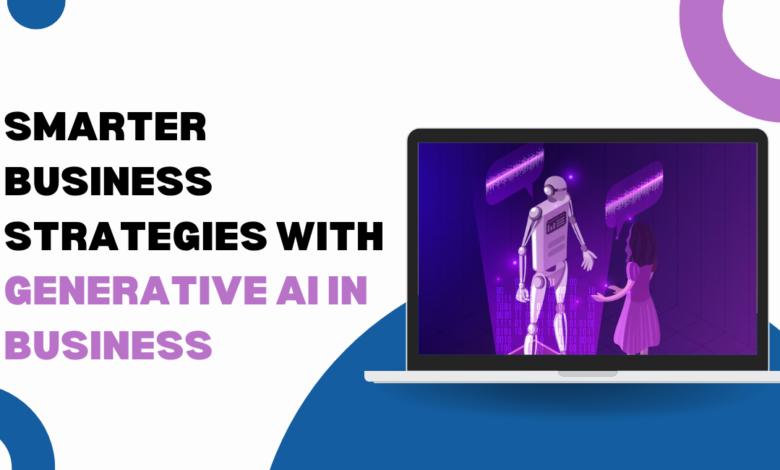Smarter Business Strategies with Generative AI in Business | by Anna Mathew | Apr, 2024

In addition to being a technical buzzword, Generative AI is revolutionizing how companies create and compete. This powerful tool allows businesses to craft personalized experiences for customers like never before and make smarter decisions faster.
Today, we will examine how Generative AI reshapes business strategies, adding billions to the economy and shifting operational gears across industries. To understand this crucially make sure to check Certification in Generative AI in Business.
Let’s get insights that could redefine your approach to innovation and efficiency.
Generative AI represents a branch of artificial intelligence dedicated to generating novel content autonomously. This advanced technology can produce text, images, and various media forms without direct human input.
Leveraging vast datasets, generative AI learns patterns and structures to create outputs that resemble but are distinct from the original data.
In business, generative AI is of immense significance. It transforms raw data into actionable insights, facilitating informed decision-making about products and services.
By harnessing this technology, companies can customize their offerings to align with customer preferences more accurately.
As a result, they witness notable enhancements in operational efficiency and customer engagement. Generative AI transcends theoretical concepts, exerting a tangible impact on economies worldwide.
Businesses spanning diverse sectors are swiftly embracing this innovation, recognizing its potential to confer a competitive advantage in today’s dynamic market landscape.
Through the integration of generative AI, enterprises experience heightened levels of creativity, productivity, and competitiveness, thereby driving economic growth and transformation.
Personalization and Customer Engagement:
Generative AI revolutionizes businesses’ customer interactions by enabling personalized experiences and heightened engagement levels.
Businesses can tailor their offerings to match individual customer preferences through generative AI, resulting in more immersive and gratifying experiences.
This technology facilitates a deeper understanding of customer behaviors and inclinations, facilitating the development of targeted marketing strategies that foster increased engagement and customer loyalty.
Enhanced Decision-Making:
Generative AI empowers businesses with advanced decision-making capabilities by leveraging data analytics, predictive modeling, and automation. By harnessing generative AI, companies can extract valuable insights from extensive datasets, enabling them to make informed and proactive decisions.
This technology optimizes risk management processes, offering cognitive computing capabilities that drive strategic transformations and redefine operational approaches. With generative AI’s support, businesses efficiently implement innovative strategies, enhancing productivity and seizing new opportunities.
Increased Efficiency and Innovation:
Generative AI boosts business efficiency by streamlining processes and enhancing productivity. Its predictive modeling capabilities aid in strategic decision-making, optimizing workflows and resource allocation based on data-driven insights.
By integrating generative AI into their operations, businesses can achieve greater efficiency and foster a culture of innovation.
Incorporation into Search Algorithms:
Generative AI has been integrated into search algorithms to enhance the relevance and quality of search results. Its capacity to comprehend context, intent, and natural language has revolutionized how search engines interpret queries, improving user experiences and engagement levels.
Through the integration of generative AI, businesses can optimize their content to align with these advanced algorithms, thus improving their visibility and ranking on search engine results pages.
Impact of the Economic Sector
Generative AI’s potential impact on productivity significantly impacts the global economy, potentially adding trillions of dollars in value. Recent research suggests that across 63 analyzed use cases, generative AI could contribute between $2.6 trillion and $4.4 trillion annually.
To put this in perspective, the entire GDP of the United Kingdom in 2021 amounted to $3.1 trillion. Moreover, incorporating generative AI into existing software applications could further amplify its economic impact, potentially doubling the estimated value.
Most of the projected value from generative AI use cases is concentrated in critical areas such as Customer Operations, Marketing and Sales, Software Engineering, and R&D, collectively representing about 75 percent of the potential value delivery.
Across 16 business functions, 63 distinct use cases exist where generative AI can address specific business challenges, yielding measurable outcomes. Examples include:
- Enhancing customer interactions.
- Creating compelling content for marketing and sales initiatives.
- Automating coding tasks based on natural language prompts, among others.
Specific industries benefit significantly from adopting generative AI, with banking, high-tech, and life sciences topping the list regarding potential impact as a percentage of revenue.
For instance, if fully implemented, the technology could contribute between $200 billion and $340 billion annually to banking. Similarly, in retail and consumer packaged goods, the potential value addition ranges from $400 billion to $660 billion annually.
These estimates underscore the transformative potential of generative AI across various sectors, promising substantial economic growth and innovation.
This information makes it easy to understand how generative AI impacts business strategies and the economic sector. It is hard to overstate the transformative power of Generative AI.
As we navigate the intricate landscapes of healthcare, retail, and insurance, it becomes apparent that embracing this disruptive technology is not simply an option but a strategic imperative for businesses across industries seeking to drive innovation, efficiency, and productivity.



